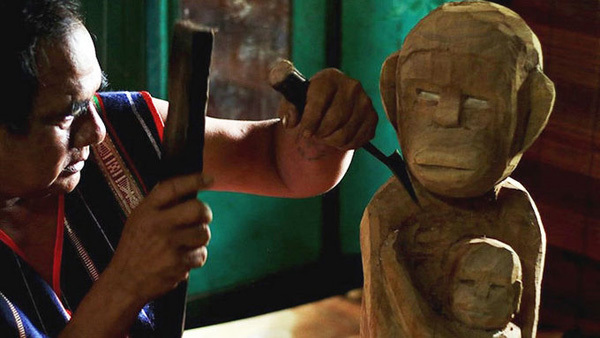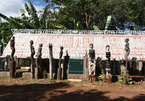 |
| Artisan K’Sor H’Nao is carving charnel house statues. (Photo: NDO) |
The grave statues have become places that haunt him whenever he visits the Central Highlands and he was stunned when he saw a big statue beside the communal house of Plei Op Village in Hoa Lu Ward.
Mysteries from the charnel-houses
Vuong Tam had a chance to enjoy a painting entitled “Le hoi Po Thi” (Po Thi Festival) by painter Le Hung, head of the Vietnam Fine Arts Association’s branch in Gia Lai Province). Hung said “po thi” (abandoning the grave) Festival of the Central Highlands region has caused him to fall in love with this wild land since the 1980s. It aims to make the dead come to the land of gods. The ethnic minority people believe that the heath is not the end the beginning of the cycle of reincarnation in the universe of human existence.
Hung also noted that Gia Lai people have a legend that after the “po thi” (also called “bo ma”) ceremony, the ghost turns into a spider in the realm of Jung (a Goddess) and then Jung releases the spider on the ground to live. The cycle of reincarnation continues when the spider is old and weak. It dissolves into water and seeps into the ground after it dies. From the clay, the Goddess molds a human that will be reincarnated into a foetus of a pregnant woman in the village. The story featured the philosophy of the Central Highland people that the death is only the beginning of a new life. Therefore, “bo ma” is one of the biggest festivals in the Central Highlands. At the festival, rituals are held to make a new home for the dead and bid farewell to them. The deceased are freed from all ties and the living also begin another life without keeping their grief and worries.
With the philosophy that ghosts have a life of their own, the living must make a new and spacious tomb. They must place items familiar to the deceased in the graves. The “bo ma” ceremony only begins when the village patriarch or the master of the house says prayers to the gods and the dead.
The “bo ma” ceremony has turned into a festival to celebrate a peaceful life and reincarnation for the ghost. They bid farewell to the ghosts with wild dances around the campfires. The young men and women sing to the rhythm of the gongs. Painter Le Hung still remembered the new lyrics in a song for this practice: “Dawn rises like a wonderful painting. Highland forests in the middle of the hills. The prosperous villages with smiles on villagers’ faces.” The wooden statues are placed outside charnel houses to guard against the sadness drifting away. The charnel house statues are considered mascots connecting ghosts with the sacred universe, according to Hung.
Happiness and sadness of statues’ faces
Making grave statues is the most important practice conducted by the living to comfort the ghosts. Clusters of statues with many scenes of activities that are connected together create a fence surrounding the charnel houses. The statues are carved on wooden trees as the main pillars of the fence. Each fence usually has 27 statues corresponding to many different themes in life. Artisan K’Sor H’Nao in Dong Da Ward, Pleiku City, said that there are four groups of statues on the main pillars. The first belongs to “the animals”, the second is for the theme of “nostalgia”, the remaining ones are the “life” and “fertility”. Specifically, statues of people crying with hands covering their faces are always placed at the four corners of the fence. The statues of cattle and activities in their daily life such as people beating drums, beating gongs, pounding rice, carrying babies and baskets are interspersed with them. Notably, the statues survival nuances are always carved in detail and the image of a pregnant woman is indispensable.
According to the ancient legend, when a chieftain passed away, the living had to bury his servants and wealth so that the ghost could still be served in the underworld. After many generations, the Gia Rai people replaced the burial of the living by carving wooden statues to protect the souls of the dead. The statues featuring crying faces aim to comfort the ghosts and those with happy faces help the ghosts rest in peace. Meanwhile, the statues of pregnant women always carry the hope that the ghost will be reincarnated soon. Each charnel house statue contains a certain philosophy of life that the living wants to convey to the dead. These folk sculptures have always left great impressions. They are wood carvings in the Central Highlands style with unique features that cannot be found anywhere else. The locals carve the statues skilfully using primitive tools such as axes and knives, thus revealing the character's miens.
The wooden statues of the Central Highland people show boldness through divine light. Artisan H’Nao added that most of charnel house statues have been carved by chiselling and flattening. To create a submerged space imbued with spiritual features, the artisans are always inspired by the contrasting depths between light and dark. Therefore, the convex parts on the human body such as forehead, cheeks, nose and chest are all flattened. They believe that the charnel house statues are formed in harmony with nature and shaped through the contrast of yin yang elements and the five elements of earth, water, wind, fire and wood. The statues can awaken viewers' curiosity and imagination.
Especially with the wear and tear of harsh weather and time, the statues depict the beauty of the wild. Many charnel houses have fences of statues that have dilapidated but still show the beauty of fairy folk through their fading.
Source: Nhan Dan

Unique touring experiences in Gia Lai and Kon Tum
Spring is the best time of the year to visit Gia Lai and Kon Tum provinces where travelers stroll in pine forests, explore local culture and enjoy the cold breeze there.